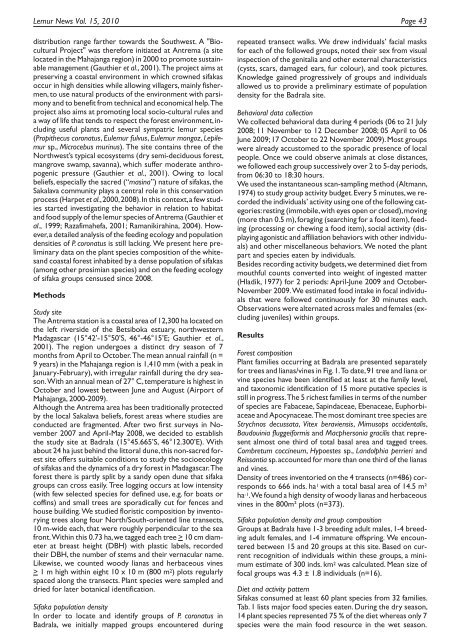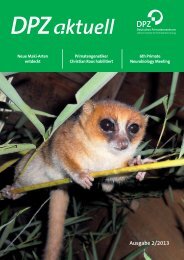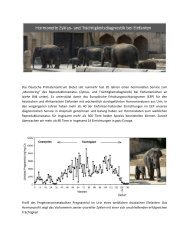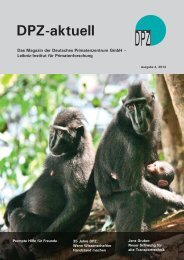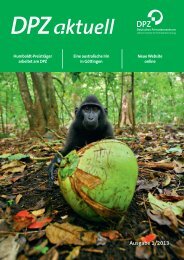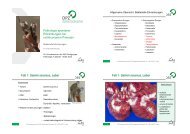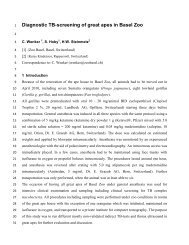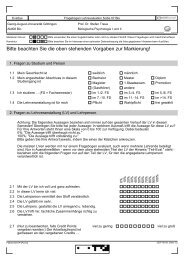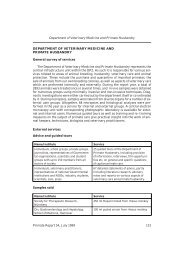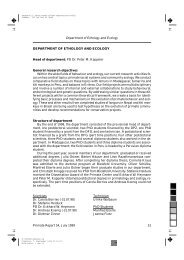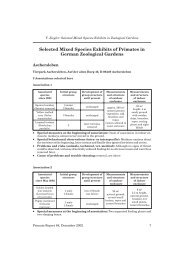Vol. 15 - Deutsches Primatenzentrum
Vol. 15 - Deutsches Primatenzentrum
Vol. 15 - Deutsches Primatenzentrum
You also want an ePaper? Increase the reach of your titles
YUMPU automatically turns print PDFs into web optimized ePapers that Google loves.
Lemur News <strong>Vol</strong>. <strong>15</strong>, 2010 Page 43<br />
distribution range farther towards the Southwest. A "Biocultural<br />
Project" was therefore initiated at Antrema (a site<br />
located in the Mahajanga region) in 2000 to promote sustainable<br />
management (Gauthier et al., 2001).The project aims at<br />
preserving a coastal environment in which crowned sifakas<br />
occur in high densities while allowing villagers, mainly fishermen,<br />
to use natural products of the environment with parsimony<br />
and to benefit from technical and economical help.The<br />
project also aims at promoting local socio-cultural rules and<br />
a way of life that tends to respect the forest environment,including<br />
useful plants and several sympatric lemur species<br />
(Propithecus coronatus, Eulemur fulvus, Eulemur mongoz, Lepilemur<br />
sp., Microcebus murinus). The site contains three of the<br />
Northwest’s typical ecosystems (dry semi-deciduous forest,<br />
mangrove swamp, savanna), which suffer moderate anthropogenic<br />
pressure (Gauthier et al., 2001). Owing to local<br />
beliefs, especially the sacred (“masina”) nature of sifakas, the<br />
Sakalava community plays a central role in this conservation<br />
process (Harpet et al.,2000,2008).In this context,a few studies<br />
started investigating the behavior in relation to habitat<br />
and food supply of the lemur species of Antrema (Gauthier et<br />
al., 1999; Razafimahefa, 2001; Ramanikirahina, 2004). However,a<br />
detailed analysis of the feeding ecology and population<br />
densities of P. coronatus is still lacking. We present here preliminary<br />
data on the plant species composition of the whitesand<br />
coastal forest inhabited by a dense population of sifakas<br />
(among other prosimian species) and on the feeding ecology<br />
of sifaka groups censused since 2008.<br />
Methods<br />
Study site<br />
The Antrema station is a coastal area of 12,300 ha located on<br />
the left riverside of the Betsiboka estuary, northwestern<br />
Madagascar (<strong>15</strong>°42’-<strong>15</strong>°50’S, 46°-46°<strong>15</strong>’E; Gauthier et al.,<br />
2001). The region undergoes a distinct dry season of 7<br />
months from April to October.The mean annual rainfall (n =<br />
9 years) in the Mahajanga region is 1,410 mm (with a peak in<br />
January-February), with irregular rainfall during the dry season.With<br />
an annual mean of 27° C,temperature is highest in<br />
October and lowest between June and August (Airport of<br />
Mahajanga, 2000-2009).<br />
Although the Antrema area has been traditionally protected<br />
by the local Sakalava beliefs, forest areas where studies are<br />
conducted are fragmented. After two first surveys in November<br />
2007 and April-May 2008, we decided to establish<br />
the study site at Badrala (<strong>15</strong>°45.665’S, 46°12.300’E). With<br />
about 24 ha just behind the littoral dune,this non-sacred forest<br />
site offers suitable conditions to study the socioecology<br />
of sifakas and the dynamics of a dry forest in Madagascar.The<br />
forest there is partly split by a sandy open dune that sifaka<br />
groups can cross easily. Tree logging occurs at low intensity<br />
(with few selected species for defined use, e.g. for boats or<br />
coffins) and small trees are sporadically cut for fences and<br />
house building. We studied floristic composition by inventorying<br />
trees along four North/South-oriented line transects,<br />
10 m-wide each, that were roughly perpendicular to the sea<br />
front.Within this 0.73 ha,we tagged each tree > 10 cm diameter<br />
at breast height (DBH) with plastic labels, recorded<br />
their DBH, the number of stems and their vernacular name.<br />
Likewise, we counted woody lianas and herbaceous vines<br />
> 1 m high within eight 10 x 10 m (800 m 2) plots regularly<br />
spaced along the transects. Plant species were sampled and<br />
dried for later botanical identification.<br />
Sifaka population density<br />
In order to locate and identify groups of P. coronatus in<br />
Badrala, we initially mapped groups encountered during<br />
repeated transect walks. We drew individuals’ facial masks<br />
for each of the followed groups, noted their sex from visual<br />
inspection of the genitalia and other external characteristics<br />
(cysts, scars, damaged ears, fur colour), and took pictures.<br />
Knowledge gained progressively of groups and individuals<br />
allowed us to provide a preliminary estimate of population<br />
density for the Badrala site.<br />
Behavioral data collection<br />
We collected behavioral data during 4 periods (06 to 21 July<br />
2008; 11 November to 12 December 2008; 05 April to 06<br />
June 2009;17 October to 22 November 2009). Most groups<br />
were already accustomed to the sporadic presence of local<br />
people. Once we could observe animals at close distances,<br />
we followed each group successively over 2 to 5-day periods,<br />
from 06:30 to 18:30 hours.<br />
We used the instantaneous scan-sampling method (Altmann,<br />
1974) to study group activity budget.Every 5 minutes,we recorded<br />
the individuals’ activity using one of the following categories:resting<br />
(immobile,with eyes open or closed),moving<br />
(more than 0.5 m),foraging (searching for a food item),feeding<br />
(processing or chewing a food item), social activity (displaying<br />
agonistic and affiliation behaviors with other individuals)<br />
and other miscellaneous behaviors. We noted the plant<br />
part and species eaten by individuals.<br />
Besides recording activity budgets,we determined diet from<br />
mouthful counts converted into weight of ingested matter<br />
(Hladik, 1977) for 2 periods: April-June 2009 and October-<br />
November 2009.We estimated food intake in focal individuals<br />
that were followed continuously for 30 minutes each.<br />
Observations were alternated across males and females (excluding<br />
juveniles) within groups.<br />
Results<br />
Forest composition<br />
Plant families occurring at Badrala are presented separately<br />
for trees and lianas/vines in Fig.1.To date,91 tree and liana or<br />
vine species have been identified at least at the family level,<br />
and taxonomic identification of <strong>15</strong> more putative species is<br />
still in progress.The 5 richest families in terms of the number<br />
of species are Fabaceae, Sapindaceae, Ebenaceae, Euphorbiaceae<br />
and Apocynaceae.The most dominant tree species are<br />
Strychnos decussata, Vitex beraviensis, Mimusops occidentalis,<br />
Baudouinia fluggeiformis and Macphersonia gracilis that represent<br />
almost one third of total basal area and tagged trees.<br />
Combretum coccineum, Hypoestes sp., Landolphia perrieri and<br />
Reissantia sp.accounted for more than one third of the lianas<br />
and vines.<br />
Density of trees inventoried on the 4 transects (n=486) corresponds<br />
to 666 inds. ha 1 with a total basal area of 14.5 m²<br />
ha -1.We found a high density of woody lianas and herbaceous<br />
vines in the 800m² plots (n=373).<br />
Sifaka population density and group composition<br />
Groups at Badrala have 1-3 breeding adult males, 1-4 breeding<br />
adult females, and 1-4 immature offspring. We encountered<br />
between <strong>15</strong> and 20 groups at this site. Based on current<br />
recognition of individuals within these groups, a minimum<br />
estimate of 300 inds. km 2 was calculated. Mean size of<br />
focal groups was 4.3 ± 1.8 individuals (n=16).<br />
Diet and activity pattern<br />
Sifakas consumed at least 60 plant species from 32 families.<br />
Tab. 1 lists major food species eaten. During the dry season,<br />
14 plant species represented 75 % of the diet whereas only 7<br />
species were the main food resource in the wet season.


